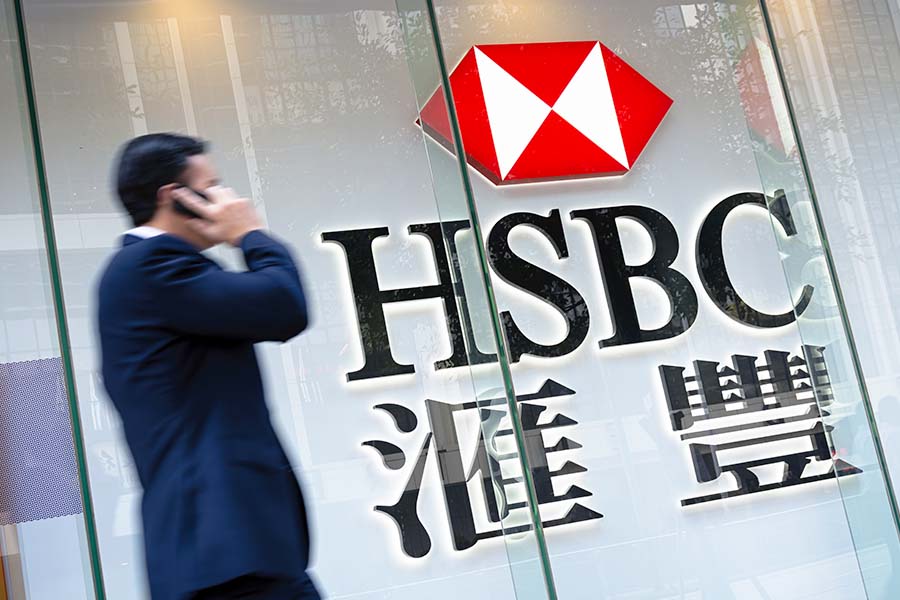
~60,000
unlocked hours
45%
of projects are cross-functional
25%
of restructured employees found new opportunities
If the concept of future skills and the future of work is important to you, the idea of a talent marketplace is one of the foundational elements that is going to help companies solve for that.
Hamish Nisbet, Group Head of Resourcing
With more than 40 million customers relying on their financial services, HSBC wanted to ensure its workforce had the capabilities needed to thrive in the new world of work. Leaders sought to develop a future-fit upskilling strategy that would break down silos, unlock potential, and fuel meaningful career development. By leveraging a Workforce Agility Platform, the leading financial institution has replaced boundaries with internal mobility and created a launching pad to prepare for the next chapter of work.
HSBC is a financial services organization that serves more than 40 million customers, ranging from individual savers and investors to some of the world’s biggest companies and governments. To serve its network of more than 60 countries and territories, HSBC draws upon its unique expertise, capabilities, breadth, and perspectives. The bank’s mission is to open up a world of opportunity for its customers, investors, employees, and the planet.
While HSBC had a rich history of excellence in financial services that spans more than a century, leaders at the bank understood the importance of turning their attention toward the future. Executives recognized that maintaining the quality of their services in the new world of work hinged on their ability to design a future-fit skills agenda.
As their Group Head of Resourcing Hamish Nisbet explains, “We were wrestling with how, as an organization, we ensure we have the right people with the right skills at the right time.” Since the business employs well over 200,000 people, the sheer size of its workforce led to talent silos that made it challenging for employees to pivot and align with business priorities.
Leaders understood that a dynamic exchange of talent and skills would be a hallmark of a future-fit skills agenda, but the organization struggled to find an effective way to power reallocations at speed and scale. “We looked at redeployments, but they were really manual. It required too much human intervention. It wasn’t systemized. And with an organization like ours, with over 220,000 employees, it’s really difficult to get that to any sort of scale,” Nisbet notes.
These discussions on the future of work and the need for a skills-based strategy put Gloat on HSBC’s radar: “Those twin points of tension led to conversations about creating an environment where employees could develop their own skills, but also match the work that the organization needed to get done. At the same time, we saw the emergence of the talent marketplace as a concept and the marriage of those two together took us down the path of exploring what those opportunities could look like,” Nisbet says.
Once leaders became aware of the talent marketplace’s potential to democratize career development and the need for workforce intelligence to power future-fit skill-building, interest in launching their own solution continued to build. They needed a tool to drive action fast, and In Nisbet’s words, “The idea of the talent marketplace started to grow until it got to the point where it was seen as a critical plank for us to succeed against those agendas.”

In order to turn their vision for a more agile workforce into reality, HSBC’s leaders developed a handful of goals to guide their project. These objectives included:
As the half-life of skills continues to shrink and a global talent shortage sets in, HSBC sought to ensure its workforce has the knowledge and capabilities needed to lead the organization into the future. “The concept of future skills was really high on the agenda for our leadership team,” Nisbet said. “How are we going to service the needs of our customers in the future? How are we going to make sure we have the organizational capability to do that?”
While some businesses leaned towards sticking with the status quo, HSBC recognized that embracing a bold new strategy with skills at the center would be integral for thriving in the new world of work. “If we carried on the way we were, we were probably going to lose,” Nisbet notes. “So we had to think about more impactful, more up-to-date, more contemporary ways that would encourage our employees to grow their skills and meet our future needs.”
With more than 200,000 employees dispersed across over 60 countries, HSBC’s workforce lacked visibility into all of the skill-building and career development opportunities that the bank had to offer. Most employees generally worked within their own teams and functional departments, meaning opportunities for cross-functional collaboration were few and far between.
“Like every other organization, we were structured by hierarchies and very contained boxes. Senior leaders understood the challenges that this approach brought to our future business success,” Nisbet explains. These same executives believed that a talent marketplace could break down boundaries and encourage employees to take advantage of skill-building opportunities across the organization. “We wanted to establish a movement to create a culture of continuous growth and development at the bank,” Melanie Lee, Group Head of HR Transformation, summarizes.
Rather than looking outside of the organization to fill skill gaps, HSBC wanted to empower its people to grow with the business. “We were going to need to become much more fluid in how, where, and when we got work done. So we started looking at internal mobility,” Nisbet explains. “We had the approval to start doing some internal heading hunting to cross-fertilize talent in the organization.”
Yet, early mobility efforts fell flat because many relied on manual input and failed to meet the speed and scale that HSBC’s leaders envisioned. “Whilst those things were happening on a more ad-hoc basis, and sometimes at a group-wide basis, the idea of a talent marketplace, which uses technology to enable and deliver that and introduced the concept of AI for the matching, made it too clear a case to ignore,” Nisbet says.

With their project goals identified, HSBC began searching for a solution that would power future-fit upskilling and reskilling at scale. Their ideal platform would go beyond the company’s immediate needs, cultivating a unified skill-building experience that would provide leaders with dynamic insights and recommendations from multiple data sources unified in a single source of truth.
In describing their search process, Nisbet notes, “We looked through a couple of lenses. We looked at functional and technical requirements. We looked at the UX and the UI, which were important to us, the credibility, and the stability of the tool. We looked at the commercial and legal requirements, and finally, we looked at the accessibility and the size and scale the solution could achieve.”
After reviewing options from both larger technology vendors and smaller startups, “… it was clear to us that Gloat was the preferred partner,” Nisbet recalls. “They had a strong use case in terms of the customers that were in play, the product set, they matched what we were looking to do and achieve, and the UX and UI were incredible.”
Given their urgent need for a mobility solution, Gloat’s Talent Marketplace capabilities were the right starting point for HSBC’s journey to adopt a more agile operating model. Following their decision, HSBC partnered with Gloat’s Change Enablement team to develop a phased launch plan. First, the bank chose to introduce its platform to its technology team based in India, since this department was already familiar with a more fluid, task-based approach to getting work done. “We started our rollout with projects and networking products, and that was a decision we made in partnership with Gloat, using their advice,” Nisbet notes. “We picked a particular audience of about 10,000 people and we chose them deliberately because they’re probably closest to that way of working when it comes to projects. They’re used to working in an agile manner. They’re used to working across silos.”
The success of the initial pilot launch paved the way for additional rollouts. Today, the talent marketplace is live to about 140,000 employees, with plans for full deployment in the coming months. “We have a runway that takes us through to Q1 2023, when it will be available to all 220,000 employees around the world, in over 60 countries and territories.”
Gloat’s platform already interfaces with three of the main HR platforms that HSBC utilizes, cementing its integral role in the organization’s digital ecosystem. “Within our HR tech stack, we have integrations with our mainframe,” Nisbet explains. ”We also have an integration for the jobs product, into our ATS, to ensure we have a consistent application approach for candidates. And finally, we have integrations with Degreed, which allows us to unify the skills feedback loop for people who want to develop and grow their skills as they go through different stages of their growth lifecycle.”
unlocked hours
45%
of projects are cross-functional
25%
of restructured employees found new opportunities
Today, HSBC’s talent marketplace plays a central role in powering the organization’s skill-building strategy. In addition to leveraging the platform to empower employees to take on new projects and experiential learning opportunities across the business, leaders also harness the data and insights the solution provides. All of the integrated data in Gloat and engagement data from the marketplace provides foundational workforce intelligence to inform strategic planning decisions and drive the next steps in HSBC’s workforce transformation.
As Nisbet notes, “The idea that we now know with greater certainty, what skills sit where and what aims people have gives us a much stronger platform to think about increasing our internal mobility, which in turn retains our global corporate knowledge and builds employee engagement as they start to understand that more and more of their goals and ambitions can be realized within HSBC.”
There are many anecdotes that highlight how the platform is bringing HSBC’s vision for a skills-based strategy to life. Most notably, the solution enables employees to make lasting progress on projects that were once hindered by silos and barriers.
“We had a colleague in our learning function who was trying to digitize some learning content and she’d been working on it for a number of months without any traction, Nisbet recalls. “She was excited about the talent marketplace and thought she’d put it out there as a project. And she had 10 or 20 responses and pulled together a multi-disciplinary team across different locations. She was able to get the work done within a number of weeks on something she had been waiting eight months to do.”
In addition to stories, there are a handful of metrics that illustrate the profound impact that HSBC’s platform is having on their organization. Nisbet pinpoints the 65,000 hours that the business has unlocked as a highlight, noting, “The reason we care about this is that it gives us two great benefits. One is it’s a great sign of the time that our colleagues are investing into their own development that they’re prepared to take on work. That’s outside their day job to grow their own careers and skill sets. And on the other side, it’s a great benefit to the organization as a whole, because we are getting work done that leaders need to deliver on.”
Reflecting on the role their platform plays in fueling HSBC’s future-fit skills agenda, Nisbet says, “[Gloat] is helping us build a skills-based organization through capturing what skills employees have and what they want to learn. It’s not the only place we do it, but it’s a really key interface. It goes into our skills taxonomy.”
This info will help our workforce agility experts personalize your experience.